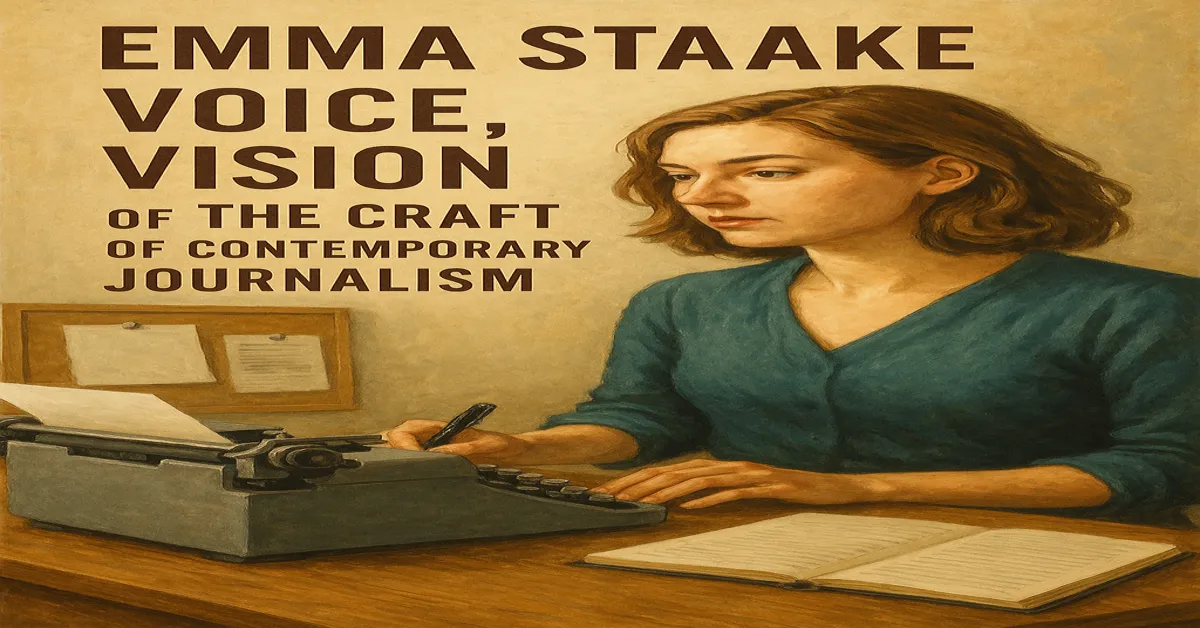In an era where headlines flash and scroll by in seconds, it’s rare for a byline to demand attention. Yet among the steady churn of digital reporting, Emma Staake has managed to carve out something distinct: a journalistic voice that is sharp without being cynical, curious without being naive, and committed to precision without losing its narrative warmth.
Known for her work across digital and print platforms, Staake has contributed features, profiles, service journalism, and cultural commentary that spans subjects from workplace dynamics to travel writing, and from human psychology to pop culture. But beyond genre, what defines Staake’s work is an unmistakable clarity of perspective—a kind of editorial confidence that neither shouts nor whispers, but simply speaks.
This article is not a biography in the traditional sense. Rather, it is a lens through which to view the changing expectations of journalism in the 2020s and beyond. Through Staake’s style, subjects, and sensibility, we can trace the evolving role of journalists as not just conveyors of information, but interpreters of cultural atmosphere.
Finding the Voice: A Writer’s Early Years
Like many writers who came of age during the digital expansion of journalism, Emma Staake’s early career was marked by versatility. She wrote across categories: travel, lifestyle, career advice, and editorial commentary. But even then, her writing stood apart—not for sensationalism, but for synthesis.
Rather than lean into clickbait tropes, Staake’s early work reflected an editorial commitment to reader service with nuance. Whether exploring how to navigate office politics or breaking down the subtle sexism baked into digital marketing, her pieces didn’t just identify issues—they contextualized them. They helped readers understand what they were seeing and why it mattered.
This reader-centered approach has become more than her signature. It is a reflection of what modern journalism increasingly demands: a combination of clarity and credibility, explanation and empathy.
The Craft: What Makes an Emma Staake Piece Distinct
To understand Staake’s journalism is to recognize its architecture. Her writing is clean, accessible, and deceptively straightforward. But it’s within that clarity that complexity lives.
1. Narrative Framing with Purpose
Staake often opens with a soft narrative hook—a single image, anecdote, or question that seems simple but unfolds into something much deeper. This device allows readers to enter the story comfortably before the weight of its significance lands.
For example, a feature on remote work might begin with a parent juggling a Zoom meeting and a crying toddler—not as gimmick, but as grounding. It turns the abstract into the tangible. It turns policy into people.
2. Voice Without Ego
In an age where too many writers conflate opinion with authority, Staake writes with conviction but without arrogance. Her tone is informed but never pedantic. There is room in her reporting for the reader’s interpretation, which is increasingly rare in journalism today.
3. Research as Respect
Whether writing a profile or a guide to navigating burnout, Staake’s work reveals thorough sourcing. She weaves together voices—experts, anecdotes, statistics—not just to bolster an argument, but to honor the complexity of her subjects.
Thematic Breadth: What She Writes About—And Why It Matters
While some journalists stick to a beat, Staake’s career is marked by range. But even across disparate topics, her stories tend to return to certain thematic centers:
1. Work and Identity
Much of Staake’s best-known writing interrogates the modern workplace. Not just job descriptions or trends, but the psychological and cultural underpinnings of labor in a post-remote, post-pandemic world.
Her writing on burnout, “quiet quitting,” and work-life boundaries doesn’t moralize. It instead illuminates the systemic structures—economic, gendered, generational—that shape how we define productivity and value.
2. Culture Through the Everyday
Staake doesn’t write about celebrity so much as she writes about what celebrity culture reveals about us. She explores the margins—what our television choices say about class, how fashion intersects with politics, how wellness culture morphs into identity performance.
In doing so, she helps readers recognize culture not as entertainment, but as a mirror.
3. Travel as Inquiry
Her travel writing often steps away from listicles and destination guides. Staake focuses instead on experiences as a lens for insight. What does it mean to be a tourist in 2025? What does sustainability mean when filtered through the real economics of travel? What assumptions do we carry with us across borders?
Her answers aren’t always definitive—but her questions linger.
Journalism in the 2020s: Why Writers Like Staake Matter
We live in a time of distrust: in institutions, in information, in intention. Journalism is caught in the crosshairs of algorithmic pressure and editorial ethics. The result is a landscape littered with noise, but short on resonance.
Writers like Emma Staake offer an antidote—not because they shout louder, but because they listen more carefully. Her work is proof that journalistic authority doesn’t have to sacrifice humility. That you can write to inform and connect.
Her clarity isn’t simplistic. It’s refined.
Her engagement with subjects isn’t transactional. It’s human.
Editorial Ethics and Empathy
In conversations about journalistic integrity, we often focus on accuracy and bias. But empathy—real, not performative—plays a crucial role in trust.
Staake doesn’t use empathy as a gimmick. She integrates it into her methodology. Whether she’s writing about burnout, travel anxiety, or cultural shifts, she does so from a place of understanding the reader’s stake in the story.
That doesn’t mean softening the truth. On the contrary, her writing can be quietly scathing—particularly when critiquing corporate hypocrisy, systemic injustice, or shallow self-help narratives. But it never feels like judgment for its own sake. It feels like critique in pursuit of clarity.
The Digital Age and the Evolving Role of the Journalist
Journalism is no longer limited to print deadlines and masthead loyalty. Writers today are expected to navigate platform shifts, SEO demands, and audience engagement metrics—all while maintaining integrity.
Staake has adapted to this landscape with agility without losing substance. Her work balances accessibility with analysis. She understands the economy of digital media, but her pieces rarely feel written for algorithms—they feel written for people.
In an industry that rewards viral heat over thoughtful light, that matters.
On Influence and Legacy (In Progress)
It may be premature to talk about legacy in the traditional sense. But influence is easier to identify. Emma Staake’s style—her synthesis of reporting and tone—has inspired a wave of writers who aim to be both grounded and graceful.
You see her influence in:
- Service journalism that respects reader intelligence
- Lifestyle writing with a critical, not consumerist, lens
- Long-form features that dare to slow down
Her work is assigned in college classrooms, shared in professional newsletters, and bookmarked by readers who want more than surface-level storytelling.
What Aspiring Writers Can Learn from Emma Staake
In a crowded field, what can young journalists, content creators, or digital editors take away from Staake’s example?
1. Know Your Reader, But Don’t Pander
Staake writes with her audience in mind, but never underestimates them. She doesn’t dumb down, but clarifies.
2. Pace Matters
Her work isn’t breathless. It’s considered. In a media culture addicted to urgency, the ability to write with deliberate rhythm is a skill worth cultivating.
3. Be Curious, Not Just Clever
It’s easy to be snarky in 2025. It’s harder—and more useful—to be curious. Staake doesn’t write to prove how much she knows. She writes to explore what we should be paying attention to.
The Future of Thoughtful Journalism
As we look forward, journalism’s role as cultural interpreter becomes more important than ever. In a world fragmented by misinformation and fatigue, readers seek not just data, but meaning.
Emma Staake’s work suggests that meaning arises when:
- Reporting is careful
- Language is intentional
- Curiosity is genuine
- And opinion is rooted in humility, not ego
Her writing is a reminder that journalism can still be a public service—not just in the stories it breaks, but in the stories it tells well.
Final Thoughts: Writing with Integrity, Reading with Intention
We often judge journalism by its subjects: the scandal, the event, the revelation. But what if we judged it by how it makes us feel smarter, more aware, more grounded? By how it helps us see more clearly, not just click more quickly?
Emma Staake’s writing does just that. It makes you pause—not because it demands attention, but because it earns it.
In an age of oversimplification, her work offers context.
In an age of outrage, her work offers insight.
And in an age of distraction, her work offers something rare: the invitation to think.
FAQs
1. Who is Emma Staake and what is she known for?
Emma Staake is a contemporary journalist and writer known for her thoughtful, human-centered reporting. She writes across a variety of genres including lifestyle, culture, workplace trends, and travel, with a signature style that blends clarity, empathy, and narrative depth.
2. What sets Emma Staake’s writing apart in today’s media landscape?
Staake’s work stands out for its measured tone, sharp insight, and reader-focused clarity. Unlike sensationalist or overly opinionated journalism, her writing prioritizes context, nuance, and thoughtful storytelling, making complex issues approachable without oversimplifying them.
3. What topics does Emma Staake typically cover in her journalism?
She frequently writes on:
- Modern work culture and mental health
- Travel with social and psychological insight
- Cultural commentary and media analysis
- Identity, gender dynamics, and societal trends
All with a strong editorial voice grounded in lived experience and research.
4. How has Emma Staake influenced younger journalists or digital media writing?
Staake’s style—balanced, insightful, and non-exploitative—has become a template for emerging writers who value storytelling with substance. Her work influences journalism classrooms, lifestyle publications, and service journalism that respects the reader’s intelligence.
5. What can aspiring journalists learn from Emma Staake’s career?
Key lessons include:
- Write with the reader in mind, not the algorithm
- Let empathy inform your reporting, not dilute it
- Focus on clarity, not cleverness
- Use storytelling to reveal patterns, not just describe events







